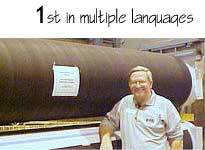Jim Thompson (jthompson@taii.com)
Week of 13 July 2009
Click here, then click "Trans lator" in top navigation bar for other languages.
One of my favorite periodicals arriving at our home each month is called "Farm Show Progress." It is printed on some fairly lousy uncoated mechanical paper and the whole thing is black & white. It has no index and seems to have no particular order. It claims to have no advertising, but I think there are some thinly disguised pieces that are really advertisements, however, since the whole thing is in exactly the same format and font, it is not noticeable except to the discerning eye. It always runs about 75 to 100 pages. It defies everything we know about modern print magazine design. Why do I like it? Content--and I read it cover-to-cover.
So what is this content? It is short story after short story (often accompanied by a grainy amateur b & w photograph) of things farmers and rural people "invent." Some are whimsical, some practical and all very, very creative. Last month, for instance, a woman (shown using this device in a picture) had taken an old rotary push mower, cut a 4 inch diameter hole in the top deck, mounted the entire thing on a big frame of wood (so it was about a foot off the ground) and was using it to chop up small trees and branches by shoving them through the hole (while standing on the deck and not wearing safety glasses).
Obviously, these creative farmers have a few advantages over us in industry: no concerns about safety (an approach I do not recommend under any circumstances), not too much of a worry about cost of the device (they make most of these things in their spare time out of junk), and obviously without much thought to reliability and maintenance.
They go from the ridiculous to the sublime. One guy in Kentucky whittles baseball caps out of wood, species your choice. All manner of agricultural equipment made from old cars, trucks, you name it. There are "furnaces" to heat one's home that burn corn cobs, cow manure, wood chips, grease from fast food restaurants, crankcase drainings and so forth and so on.
What I like about this is, as Jeff Foxworthy puts it, "The glorious unsophistication of it all."
We could use more of this in the pulp and paper industry, providing we stay alert for safety and other fiduciary issues we may have. I think the reason we don't do more of this, is because we are not trained to think this way and we tend to look disparagingly at ideas from unconventional sources. We can train ourselves to think more like this and we can overcome our haughtiness of idea sources, if we will only allow ourselves to do so.
One idea as an example. Papermachine rooms are always hot. Out on the operating floor, this obviously represents a loss of heat that cost money (we certainly don't need to heat operators to 95F [35C]). There seem to be two reasons for this--the wet end is often open to the atmosphere and the dryer hood is poorly insulated. No doubt some engineers somewhere have done calculations that say wasting this heat is more economical than capturing it (they may have also made a calculation that says heating all the makeup air is more economical than heating only the air consumed in the dryer sections, too). However, there has to be some wasted heat here that can be captured at little cost. Suppose you have a situation where your incoming mill water is cool and you have to heat it--heat it with a source associated with an incremental cost (that is, if you could turn it off, your energy costs would go down). Well, let's lay a large diameter hose on the hood of your dryers, in a serpentine fashion, and pump all the cool water through it in order to heat it up. On a typical machine, this hose will be over 4,000 feet (1,220 meters) long. At a flow rate of 5 fps (feet per second) (150 cm/s) the dwell time on the hood is over 13 minutes, plenty of time to pick up some of this heat. Several things to watch out for, of course: can the hood structure support all the weight of the hose full of water; what does this do to housekeeping on top of the hood; what happens if the hose springs a leak; and is your crane hook clearance so tight that there is a danger of snagging the hose with the house crane? Overcome these concerns, and I'll bet you one can heat their incoming water for free with no detriment to papermachine performance--there is "free" heat leaking out the top of your hood for sure.
Such a project does not involve calculus, finite element analysis, phase change studies or anything else you learned at the university. It is just simple old fashion common mechanical sense.
In these days of tight budgets, we should be encouraging our employees to look for these kinds of projects. Reward them when projects work. Make a big deal of it. It may just make a difference in profitability this year.
But I have to emphasize safety, safety, safety, when we get this creative. The "Farm Show" magazine participants obviously don't always think of safety, but we have no excuse--it must be number one for us.
Be safe and we will talk next week.
